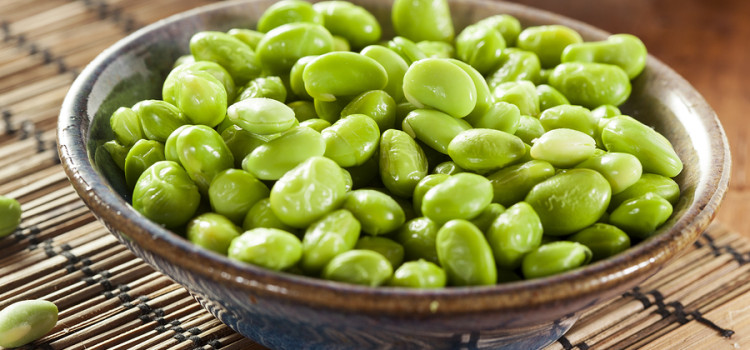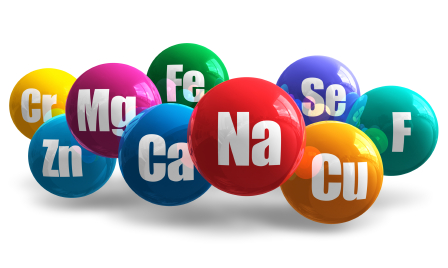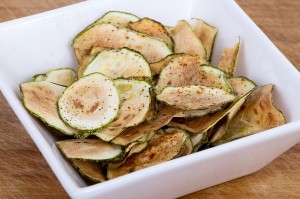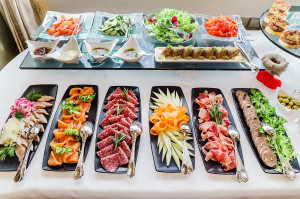

Edamame is a “young soybean.” That means that it’s harvested early, before it has a chance to fully mature and harden.
It’s gluten-free, cholesterol-free, and low in calories.
In addition to being a welcome source of protein (particularly for vegans and vegetarians), edamame offers iron and calcium.

Where did it come from?
Edamame got its start in Japan, and was introduced to Americans as a side-dish just as sushi joints started to soar in popularity. Of course, the national sushi craze coincided with a period of renewed interest in embracing wellness and healthy eating habits so it’s no surprise that the protein-rich soybean was welcomed with open arms.
Edamame is one of the most recent foods to make a grand entrance- shooting to the height of popularity seemingly almost overnight. Like quinoa and kale before it, edamame is one of those rising-star foods.
Foods go in and out of fashion all the time. Just think of those old gelatin-based vegetable dishes from the 1960s, or the fact that Salisbury steak was once a menu mainstay. Diet drinks that fly off the shelves today will be replaced with different ones in another few years, and apples have already lost their long-standing title of America’s most popular fruit to bananas.
Food fads have a tendency to grow by word of mouth just like movie or bar recommendations, but the Trim Down Club prefers to do it’s homework based on real research when it comes to health, nutrition and healthy living so without further ado here are the five most important things we think you should know before adding edamame to your grocery list.
What’s the difference between edamame and soybeans?
As we mentioned, when comparing Edamame with Soy Beans it is basically a question of age. Edamame is an immature version of soybeans. As the plant matures, it grows, develops and certain qualities like vitamin and mineral content change. Edamame is still just a young Soya bean which means that the similarities are numerous but if you’re trying to decide which you want to make your next go-to snack, it’s important to understand where and how they differ- and these differences can be quite pronounced.
Soybeans definitely have edamame beat when it comes to folic acid. (Remember folic acid? It’s the reason young women everywhere are nagged by their mothers to take daily multivitamins. Getting enough folic acid can prevent certain birth defects). While you can get 679 micrograms of folic acid in a cup of soybeans, edamame only offers 35. While a cup of edamame provides 71 milligrams of calcium, a cup of soybeans surpasses half the daily recommended amount of calcium at 500 milligrams. Remember, calcium is crucial to strong bones. Soybeans are higher in dietary fiber and also surpass the daily recommended amount of iron at 29 milligrams—edamame has just 2 milligrams. So far, soybeans are looking pretty good.
Edamame, however, shines when weight loss become important. Edamame has much less fat (17 grams, compared to 37 grams in soybeans), with the type of fat in soybeans (omega-6) not being very good in high amounts, especially for women. Edamame provides 28 grams of carbohydrates, and raw soybeans provide 56- double the amount. Finally, a cup (approximately 186 grams) of raw soybeans has twice as much protein (enough to exceed the daily recommended amount for the average person) but also far more calories (830 calories to edamame’s 376). In the final analysis the competition edamame and soy beans have more to do with the kind of diet you are following and leaves us unable to say which is better or worse for you. They are the same thing, but very different.
What are the health benefits of edamame?
Edamame is good, there’s no doubt about it. But that’s not why it’s popular. Edamame has been turning up in health food stores everywhere for just that reason: it’s healthy. If you’ve been thinking about replacing your favorite junk food (potato chips?) with edamame, chances are it’s because you think that would be a great addition to a health-conscious lifestyle. That’s why it’s so important that you know exactly what you’re getting out of the deal. Is edamame healthy?
Edamame, like other soy foods, contains isoflavones. These have been linked in studies to a lower risk of osteoporosis and cancer. Eating soy foods (not just edamame) has also been linked to a reduction in symptoms of migraines and PMS.
Here’s what else we know:
- If you come from a population that eats more soy, you have a lower chance of getting Alzheimer’s.
- If you consume at least 10mg of soy every day, you can decrease the chance for recurring breast cancer by 25%.
- If you’re a type-2 diabetic, you might appreciate what soy protein can do to prevent kidney disease.
- If you’re looking to get more iron into your diet, edamame can do the job and help your body regulate its energy use.
- If you’re looking for better sleep and memory, the nutrient choline (found in edamame) can help.
And that’s just the tip of the iceberg!
What can edamame offer women?
Obviously, we’re all human. That doesn’t make it any less important to be aware of the differences between men and women, though—particularly when it comes to nutrition. Try to frame your questions about new vegetables and foods within the context of other important health factors (such as sex). Here’s what you need to know about women and edamame:
Women are at a higher risk for osteoporosis than men, especially as they age. It’s a good idea for women to work on increasing bone density. This can be achieved by adding about 40 grams of soy protein to your diet each day.
You may have heard that a soy diet in animals can increase the risk of breast cancer. In humans, however, it’s a different story. While studies in Asian countries have actually shown links between daily soy consumption and a decrease in the risk of breast cancer, Westerners have to be content with the fact that we have never found any kind of link between soy and breast cancer, positive or otherwise.
Is there a “catch” to edamame?
The question of the hour. Part of what makes the internet so interesting and difficult at the same time is its ability to offer millions of conflicting ideas on the exact same topic. The debate on possible side effects while eating edamame is lively and there is no definitive consensus at this time.
We have all heard the saying: “All things in moderation” and this is probably the only thing that all parties in the debate can agree on right now. People that consume large amounts of edamame MAY be exposing themselves to some potential issues.
While allergic reactions to soy (rashes and itching) are only relevant to those with the allergy, everyone should be aware of its possible mild side-effects in some people:
- nausea
- bloating
- constipation
These are the fairly well known, and more widely acknowledged, possible side effects of having too much soy (and edamame) in your diet.
One of the more serious possible problems is that too much Soy can lead to too much estrogen (which can lead to its own side-effects, most significant in men like impacting on male fertility). The key word here is, as always, “excess.” If you’re eating too much of anything, its potential health benefits quickly morph into serious side-effects and symptoms. In moderation, these problems (and others) diminish.
Dr. Kaayla Daniel makes another important point on this question. First off, she warns against eating edamame raw. “You don’t want to eat edamame raw,” she says, “Ever.”
According to Dr. Daniel, edamame has to be cooked in order to decrease the toxins and phytoestrogens present. Even after that step, they’ll be there. That’s where moderation comes in. If you eat edamame too often (yes, even cooked edamame), you’ll find that these toxins and hormones begin to add up. It’s possible that they’ll never cause you any harm, and it’s possible that they will. Best to keep a good head on your shoulders and maintain a healthy, moderate amount of edamame in your life. As the good doctor says: Edamame is NOT popcorn.
How do you eat edamame?
There are MANY ways of eating edamame but there are certain steps and techniques that are pretty much universal when preparing edamame for use:
- Moderation- the jury is still out on the various effects that edamame has on people of various ages, genders and medical situations. One cup for an adult is probably the safest daily limit for edamame.
- Boiling or Steaming first- edamame almost always requires some cooking and steaming or boiling are pretty much universal initial treatments before the serious cook gets started on edamame.
- Don’t eat the seed pods! Shell the beans after they have been steamed or boiled. The pods contain a lot of the bad things that raw edamame has too: antinutrients, toxins and phytoestrogens. Even after cooking, the pods retain too much of these things to be good for you.
Beyond this, the sky is the limit. Edamame has been on people’s plates for a few thousand years and with its soft texture it can be used any way you like. They can be eaten plain as a snack substitute, used in a salad like a bean, mashed into a paste, cooked into rice dishes or steamed and served as a side to sushi dishes. It’s a bean and can easily be used in soups or slow cooker recipes too- it is extremely versatile.
Have fun, be safe and enjoy your edamame (in moderation!)
There are 5 foods to avoid- learn about them here.
Comments 7
Leave a Reply
You must be logged in to post a comment.




hate,hate,hate edamame! what do you sugest to replace?
I am deathly allergic to iodine and seafood. I stop breathing when I have them. scary stuff!!!
How much water a day? I did not find that amount in readings.
when you allow “rice cakes” is that quacker patties? or rice crackers from SESMARK. they are gluten-free and allow 16 per serving.
Where is the daily journal and write down menu consummed?
Hi, Fran. Edamame is a source of protein and fiber, which it has in common with other legumes – so they can be a swap, though note that they are about twice as high in carbohydrates. As a source of protein, you can have any other protein instead of it – for example, for each 1/2 cup of edamame, you can have an ounce of cheese, or poultry/meat/fish.
The amount of water you need is about 8 8-ounce glasses per day, less if you have heart failure or on kidney dialysis, and more if you lose a lot during intense workouts and/or in high-heat conditions.
When we say “rice cakes,” we are referring to these: https://commons.wikimedia.org/wiki/File:Puffed_Rice_Cakes.jpg. The ones from Sesmark are what we mean by rice “crackers” (6 per serving).
The daily journal is in “Apps” (link near the top of this page).
Is the “soy” in the Omega Krill 5X gel capsule, organic?
What are the ratios in the different foods for each meal, to make them healthy?
Hi, Ramona. The soy in the capsule is non-GMO – no worries.
The ratios for the meals are approximately 1 gram each of protein and fat for each 3 grams of carbohydrates.
what are the 5 foods to avoid? I don’t have time to watch videos since I work and when I
get home very tired. I wish we could read articles. I feel this trimdown club is not working since
I don’t have the time to watch videos. I would prefer menus for each meal. Is it possible to receive
them?
Hi, joakland. The 5 foods are examples of those that are overprocessed versions of those that should be healthy, but have been manipulated into being particularly harmful to your goals here. Note that they are only examples, and many other popular foods have been similarly affected, so it is important to look for better versions, endeavor to eat whole foods as much as possible, and always be aware of how a food is made.
1. Regular “whole wheat” bread – this often also contains refined flours, so it is preferred to select “100% whole” grain products (wheat or other). Even with these products, be sure to read the label and avoid hydrogenated fats or similar ingredients such as mono- and diglycerides.
2. Regular margarine – this is often made from chemically altered fats that create health risks similar to those people are trying to avoid by eating a plant-based product. If you must use a hardened oil, t is better to choose those based on coconut oil, and otherwise to use healthy liquid oils, such as olive, as much as possible.
3. Artificial sweeteners – you can read more about this here: https://www.trimdownclub.com/the-best-way-to-sweeten-your-tea-2.
4. Regular orange juice – If it is in a store, it is likely to have been stripped of what makes it healthy. Even if vitamins etc. have been added back in, it really is not the same. Fresh-squeezed is the way to go.
5. Conventional and overly processed soy – organic is fine, and minimally processed items such as tofu, yogurt, and milk, as well as fermented items such as tempeh and natto are fine. However, most pre-packaged mock meats tend to be a problem.
Yes and I just learned about GMO food such as corn since it is injected with so many things and fed to animal and now it reached humans to consume it. I guess we have to avoid corn syrup in foods too as far as I understood.